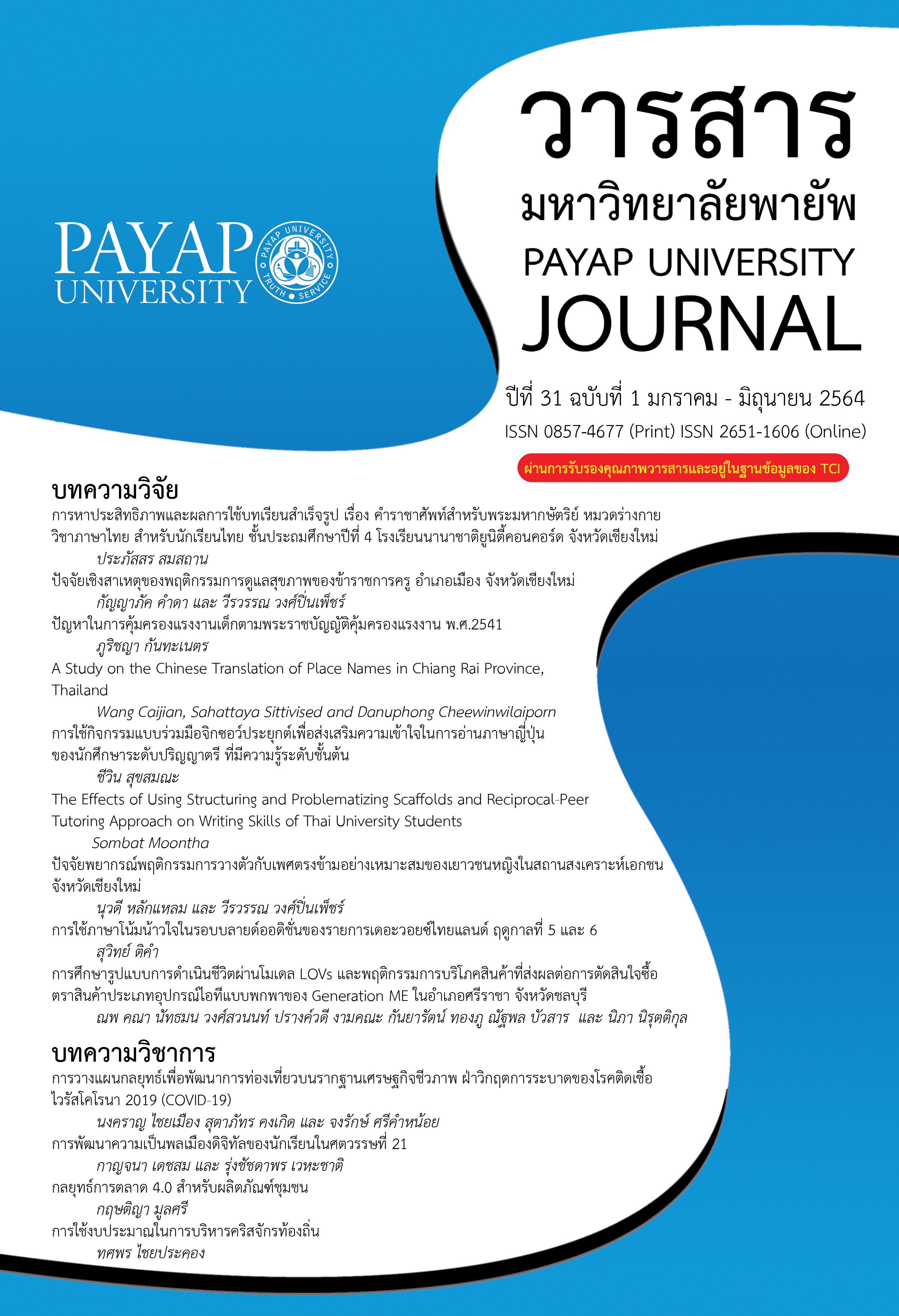การศึกษารูปแบบการดำเนินชีวิตผ่านโมเดล LOVs และพฤติกรรมการบริโภคสินค้า ที่ส่งผลต่อการตัดสินใจซื้อตราสินค้าประเภทอุปกรณ์ไอทีแบบพกพาของ Generation ME ในอำเภอศรีราชา จังหวัดชลบุรี
Main Article Content
บทคัดย่อ
การวิจัยครั้งนี้ มีวัตถุประสงค์เพื่อศึกษารูปแบบการดำเนินชีวิตผ่านโมเดล LOVs และพฤติกรรมการบริโภคตราสินค้า ที่ส่งผลต่อการตัดสินใจซื้อสินค้าประเภทอุปกรณ์ไอทีแบบพกพาของกลุ่มเจนเนอเรชันมี เป็นการวิจัยเชิงปริมาณ ประชากรที่ใช้ในการศึกษาครอบคลุมกลุ่มคน 3 เจนเนอเรชั่น ได้แก่ เจนเนอเรชั่นเอ็กซ์ เจนเนอเรชั่นวาย และเจนเนอเรชั่นแซด ที่เกิดในช่วง พ.ศ. 2508-2546 และมีพฤติกรรมการชอบใช้เทคโนโลยีเหมือนกัน อาศัยอยู่ในอำเภอศรีราชา จังหวัดชลบุรี จำนวนทั้งสิ้น 400 คน เครื่องมือการวิจัย ได้แก่ แบบสอบถามออนไลน์ วิเคราะห์ข้อมูลโดยใช้สถิติเชิงพรรณนา ได้แก่ ค่าร้อยละ ค่าเฉลี่ย ค่าเบี่ยงเบนมาตรฐาน และใช้สถิติเชิงอนุมาน ได้แก่ การวิเคราะห์ถดถอยเชิงเส้นพหุคูณแบบขั้นตอน ผลการศึกษาพบว่า ปัจจัยรูปแบบการดำเนินชีวิตผ่านโมเดล LOVs ส่งผลต่อตัวแปรตาม 3 ด้าน ได้แก่ ด้านความสนุกสนานและความเพลิดเพลิน ด้านความรู้สึกเป็นเจ้าของ และด้านการสนองความพอใจของตนเอง รวมถึงปัจจัยด้านพฤติกรรมการบริโภคตราสินค้า ที่ส่งผลต่อตัวแปรตาม ได้แก่ ปัจจัยด้านค่านิยม และปัจจัยด้านอิทธิพลของวัฒนธรรม ส่งผลต่อการตัดสินใจซื้อตราสินค้าประเภทอุปกรณ์ไอทีแบบพกพาของกลุ่มเเจนเนอเรชั่นมี จังหวัดชลบุรี อย่างมีนัยสำคัญทางสถิติที่ระดับ 0.05
Article Details
เอกสารอ้างอิง
ธาตรี ใต้ฟ้าพูล. (2563). รูปแบบการดำเนินชีวิตและพฤติกรรมการบริโภคตราสินค้าของเจนเนอเรชั่นมี. วารสารการประชาสัมพันธ์และการโฆษณา คณะนิเทศศาสตร์ จุฬาลงกรณ์มหาวิทยาลัย, 13(1), 24-38.
ธีรพันธ์ โล่ทองคำ. (2558). จับ Gen Me ให้อยู่หมัด ด้วยโมเดล E to I ตอนที่ 1 ศึกษา Generation, สืบค้นเมื่อ 8 กุมภาพันธ์ 2564. https://marketeeronline.co/archives/29289
ปริญ ลักษิตานนท์. (2536). กลยุทธ์การตลาดและการประยุกต์ใช้จริงในทางธุรกิจในแต่ละกรณีตัวอย่าง. กรุงเทพฯ: พัฒนาศึกษา.
ภรภัทร รุจยาชยะกูร. (2560). จะขายของแดนไกล อย่ามองข้ามเรื่องวัฒนธรรม, สืบค้นเมื่อ 8 กุมภาพันธ์ 2564. https://www.softbankthai.com/Article/Detail/1963
มณีรัตน์ รัตนพันธ์. (2558). ปัจจัยทางการตลาดที่มีผลต่อการตัดสินใจซื้อสินค้าและบริการผ่านช่องทางออนไลน์ของผู้บริโภคในจังหวัดภาคใต้ตอนล่าง ประเทศไทย. วารสารหาดใหญ่วิชาการ มหาวิทยาลัยหาดใหญ่, 13(2), 145-153.
วิไลลักษณ์ ทองคำบรรจง. (2553). ปัจจัยเชิงเหตุและผลของพฤติกรรมติดอินเตอร์เน็ตของนักเรียนชั้นมัธยมศึกษา ช่วงชั้นที่ 3 ในเขตกรุงเทพมหานคร. ปริญญานิพนธ์ ป.ร.ด. (การวิจัยพฤติกรรมศาสตร์ประยุกต์) บัณฑิตวิทยาลัย.
วุฒิ สุขเจริญ. (2559). พฤติกรรมผู้บริโภค (CONSUMER BEHAVIOR) (พิมพ์ครั้งที่ 3). กรุงเทพฯ: จุฬาลงกรณ์มหาวิทยาลัย.
วรรณา วันหมัด. (2558). ปัจจัยส่วนบุคคลที่ส่งผลต่อพฤติกรรมในการตัดสินใจซื้อสินค้าทางอินเทอร์เน็ต. วารสารวิจัยราชภัฏพระนคร คณะบริหารธุรกิจ มหาวิทยาลัยเกริก, 10(2), 132-141.
สำนักงานพัฒนาธุรกรรมทางอิเล็กทรอนิกส์ (องค์การมหาชน). (2563). รายงานผลการสำรวจพฤติกรรมผู้ใช้อินเทอร์เน็ตในประเทศ ปี 2562, สืบค้นเมื่อ 19 มีนาคม 2564. https://www.etda.or.th /th/NEWS/ETDA-Revealed-Thailand-Internet-User-Behavior-2019.aspx
เสรี วงษ์มณฑา. (2550). การวิเคราะห์พฤติกรรมผู้บริโภค. กรุงเทพฯ: ธีระฟิล์ม.
อรระยา ณรงค์ชัย. (2554). ค่านิยมในสังคมโลก, สืบค้นเมื่อ 19 มีนาคม 2564. http://onraya505.blogspot.com
Cochran, W. G. (1977). Sampling techniques (3rd ed). New York: John Wiley & Sons.
Etzel, M. J., Walker, B. J., & Stanton, W. J. (2007). Marketing (14th ed.). Boston: McGraw – Hill.
Frank N. Magid Associates. (2012). The first generation of the twenty first century an introduction to the Pluralist generation. New York: Magid Generational Strategies. https://static1.squarespace.com/static/56d7388222482e1e2c87c683/t/56e0cdc2cf80a14684670194/1457573327672/MagidPluralistGenerationWhitepaper.pdf
Kahle, L. R. (1986). Alternative measurement approaches to consumer values: The list of values (LOV) and values and lifestyle segmentation (VALS). Journal of Consumer Research, 13(3), 405-409.
Kahle, L. R., & Kennedy, P. (1989). Using the list of values (LOV) to understand consumers. Journal of Consumer Marketing, 6(3), 5-12.
Schwartz, S. H. (1992). Universals in the content and structure of values: Theory and empirical tests in 20 countries. Advances in Experimental Social Psychology, 25(1), 1-65.


